How to Grow Bell Peppers for Beginners
If you love peppers as much as I do, this article is for you. Learn how to grow bell peppers for beginners and fill your backyard garden with delicious peppers you can enjoy all year long.
Gardening 101 help so that you can expand year after year until all the food you need is right outside your back door.
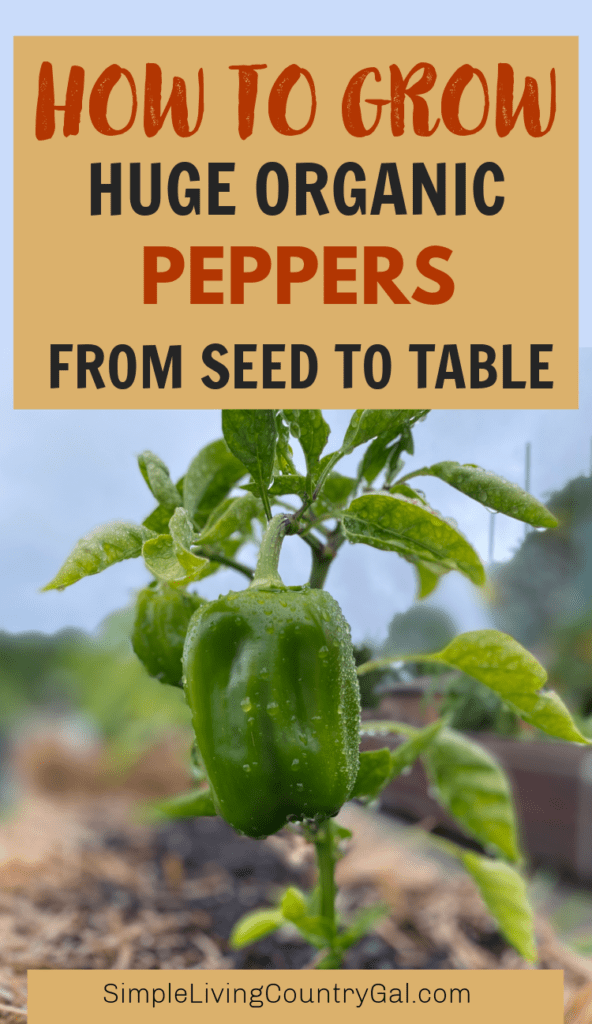
With their variety of shapes, colors, and sizes, bell peppers are a wonderful addition to any warm-weather garden. They also resist the most common garden pests and diseases and are fairly easy to grow, making them perfect for any beginner gardener.
Bell peppers have a long growing season, about 60 to 90 days, so starting them indoors is usually a good option, especially for gardeners in the north. Northern gardeners can plant earlier in the season, especially if they warm the soil by covering it with black plastic in the late winter to early spring.
Peppers are a good source of vitamin C; they’re also delicious, both raw in salads, cut up and accompanied by savory dips, cooked in stir-fry’s, or stuffed with beef and cheese. With so many fun dinner options growing peppers in your backyard garden is a great idea.
Bell peppers come in many colors, all with varying tastes, and you’ll want to grow a few varieties to bring color and nutrition to your garden and your table.
What different types of bell peppers are there?
Let’s talk about a few pepper options so you have a better idea of what you may want to plant and grow this year.
Red Bell Peppers
Red Bell Peppers are perfect for grilling, roasting, adding to sauces and salads, or enjoying raw with dip. They’re on the sweeter side, and when they’re left to fully ripen, they’re full of beta-carotene and Vitamins A and C.
Yellow Bell Peppers
Yellow Bell Peppers are firm and crisp with a high juice content. They’re also perfect for grilling or roasting and are delicious in pasta dishes. You can even add them to smoothies and juices. Pair with apple, lime, and ginger for a delicious and healthy juice.
Orange Bell Peppers
Orange Bell Peppers make a great addition to salsas, can be stuffed to make a healthy meal, and make a colorful addition to a veggie tray. They’re full of antioxidants, folic acid, fiber, and iron, not to mention they’re high levels of Vitamin C. Add some to a morning egg scramble or into a quesadilla.
Green Bell Peppers
Green Bell Peppers add a nice crunch to salads and veggie plates, are delicious stuffed, and make a nice addition to kabobs on the grill. They’re more commonly seen in recipes and pair nicely with tomato sauces.

Seed, Bulb, or Plant?
Peppers start as a seed and do well when they are started indoors and then transplanted in the garden when the temperatures warm up. Plan to start sowing the seeds indoors about 6 to 8 weeks before transplanting and make sure the seedlings are kept in a warm area throughout germination.
What You Need to Grow Bell Peppers
Bell peppers need full sun and well-draining soil to thrive. Soil should be somewhere between sandy and loamy so that it drains quickly and stays warm. If you’re working with heavy clay soil, you’ll want to mix in plenty of compost or other organic matter.
If you are short on space, you can grow bell peppers in containers right on your back porch.
When to Plant Bell Peppers
Peppers shouldn’t be planted outdoors until 4 to 6 weeks after the last frost. Start the seedlings indoors about 6 to 8 weeks before you plan to transplant them outside.
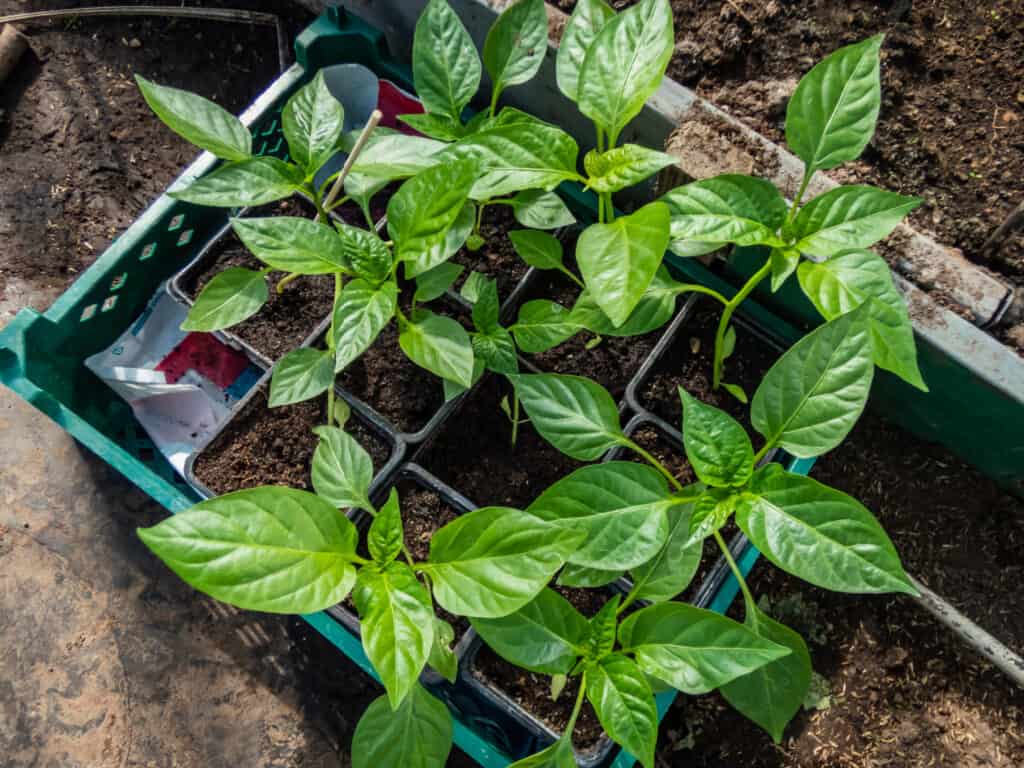
Temperature
Soil temperature should remain at or above 75°. Bell peppers love warm weather and will germinate faster when the temperatures are warmer. Start indoors and keep the seedlings in an area that remains 75° to 90°. Don’t transplant until the nighttime temperatures outdoors remain above 50°.
Sun
Bell peppers need to be planted in areas where they can receive at least 6 to 8 hours of sunlight per day. Before planting, watch the sun’s movement around your garden area to determine the best spot for planting.
Soil
Soil should be a balance of sandy and loamy soil so that it drains well and warms quickly. Add plenty of organic matter, such as compost, before planting to add nutrients to the soil. If you’re working with heavy clay soil, organic matter will also help to lighten the soil and allow it to drain better.
Water
Bell peppers will need regular watering, about 1 to 2 inches per week. Peppers like a good dousing over a shallow water, so water heavily, then allow to almost dry out before watering again. They do need short periods of relative dryness. Deep watering will help the root system to grow strong. Don’t let them go so long between waterings that the plants start to wilt, though; this will reduce the yield and the quality of the fruit.
Inconsistent watering can also make them susceptible to blossom-end rot so stick to a watering schedule.
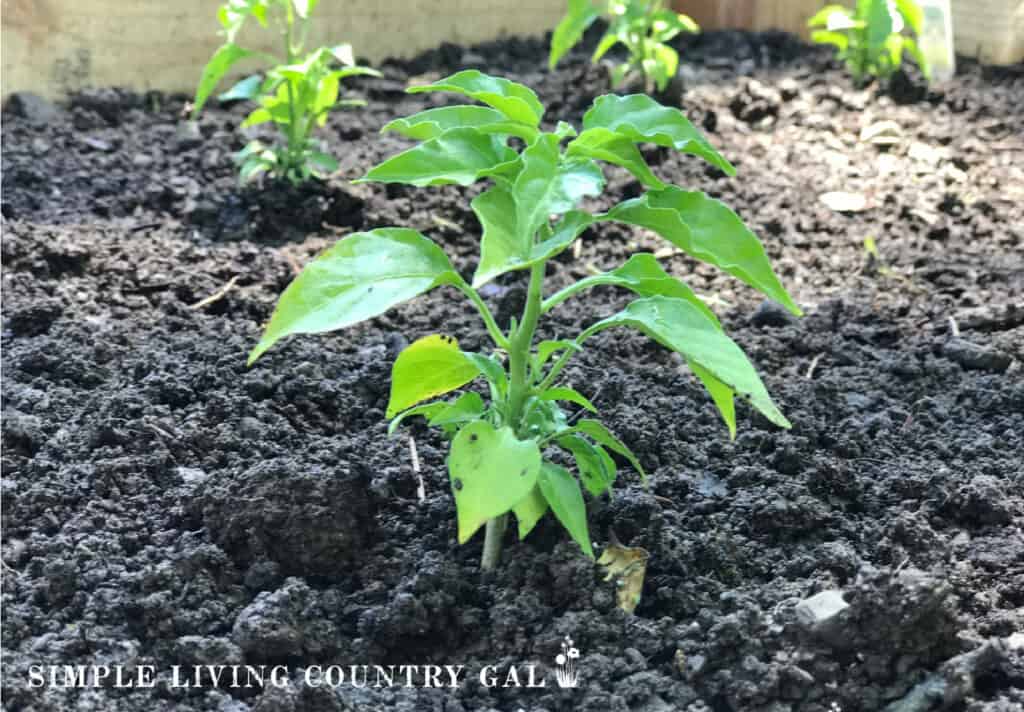
Fertilizing
Before planting, fertilize the soil with a mix of aged manure and compost. Work it into the soil about 8 to 10 inches deep and rake it several times to break up clods.
Support
You will need to stake the plants to support the growth of the vines. It’s better to place the stakes when you transplant the plants instead of later when it can disturb the roots.
How Much to Plant
Bell pepper plants will usually yield a high amount of fruit. To enjoy them all summer long, plan on planting about 3 to 5 plants per person in your household.
How Long Do Bell Peppers Take to Grow?
Seeds will start germinating in about 14 to 21 days, and peppers will be ready to harvest in about 60 to 90 days, depending on the variety and your growing conditions.
How to Plant Bell Peppers
Plan to start your pepper plants indoors in pots about 6 to 8 weeks before your last spring frost. Transplant them outdoors about 2 to 3 weeks after the last frost and make sure the soil has reached at least 50° but preferably 65°. This will ensure the peppers have warm enough temperatures, even overnight, for the plants to thrive.
Starting Bell Pepper Plants Indoors
Plant seeds 1/4” deep with three seeds to a pot. This will help to ensure at least one healthy plant per pot, and any others can be thinned later. For faster germination, keep the seed pots in an area where the soil can maintain a constant 70°. You may need a heated propagator or mat, and some grow lights.
With proper growing conditions, seedlings should start appearing in about two weeks. Some varieties may take as long as five weeks, so check your seed package and don’t give up on them too soon.
Once they start to grow, thin out the weakest seedling from each pot and let the other two grow together into one plant. This will create more leaves which will protect the peppers as they grow.
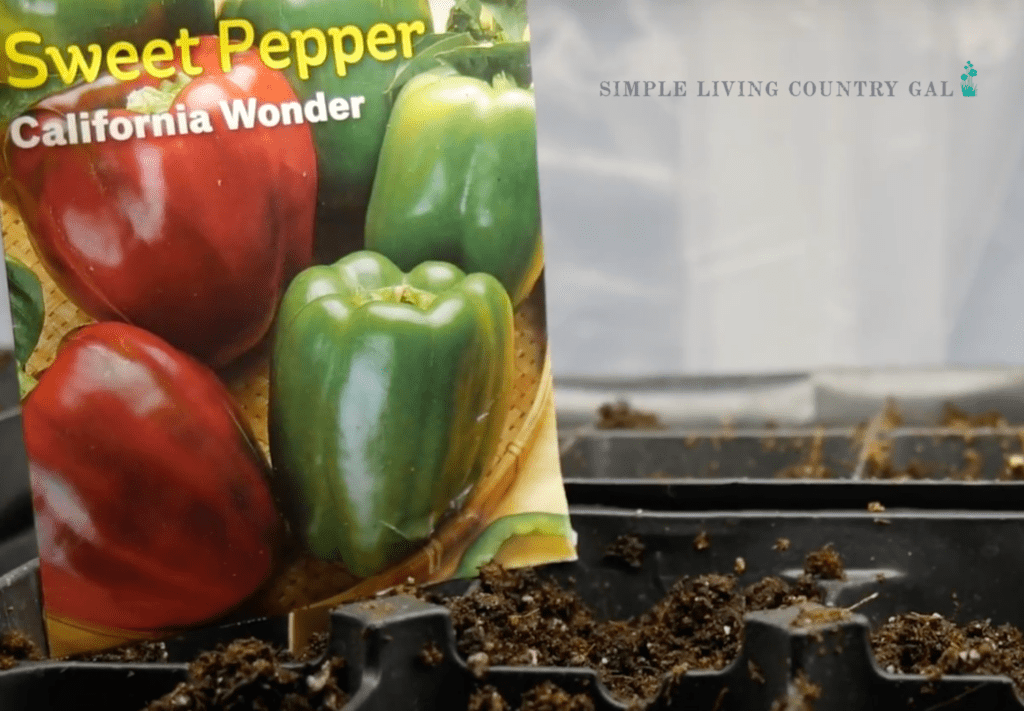
If seedlings become too tall or leggy before transplanting, replant them in a larger pot with soil up to their lowest leaves. This will help to support the plant. If the plants have about 5 to 8 leaves per plant and you can see the roots through the drainage hole of the pot, it’s to replant them to a larger pot.
Before transplanting outdoors, harden the seedlings off for about 10 day by placing them outside during the day so they can adjust to cooler temperatures gradually.
Transplanting Bell Peppers Outdoors
Once the temperatures warm up, your transplants will be ready to move outside. Mix some aged manure and/or compost into the soil about 8 to 10 inches deep. Rake the soil to break up any large clumps. Don’t transplant into the ground until the soil temperature has reached at least 65°. If you need to speed up the warming of the soil, cover it with dark mulch or black plastic about a week before planting.
Transplant in the evening or on a cloudy day to keep the plants from drying too much and wilting. Dig transplant holes about 3 to 4 inches deep and about 12 to 18 inches apart in a row. Rows should be spaced 2 to 3 feet apart.
Before planting, fill the holes with water and let it soak in, then place 2 or 3 wooden matchsticks (for sulfur) and one teaspoon of a low-nitrogen, high-phosphorus fertilizer. Too much nitrogen in the soil will reduce the fruit yield.
When removing the transplant from its tray or pot, do it gently and leave as much soil as you can around the roots. Place the transplant in the ground about 1 inch deeper than they were in their original pot. Fill the hole with soil and pack it loosely around the plant, leaving a slightly sunken area around the plant base to hold water.
After planting, give the plants good watering. A liquid fertilizer material such as manure tea or starter fertilizer can be beneficial to the plants at this time.
Stake the plants now to avoid damaging the roots later. You can also use cages. This will help to prevent the plant from bending under the weight of the fruit as it grows.
Growing Tips for Bell Peppers
• When selecting a planting area, avoid areas where other members of the nightshade family have been planted (tomatoes, eggplants, potatoes). Planting in these areas makes the peppers more susceptible to disease.
• If temperatures are too hot, you may need to water daily and mist the plants.
• Shade cloths and row covers can help the plants avoid heat stress.
• Mulch around the base of the plants to help them retain moisture and deter weeds.
• Weed carefully, so you don’t disturb the roots.
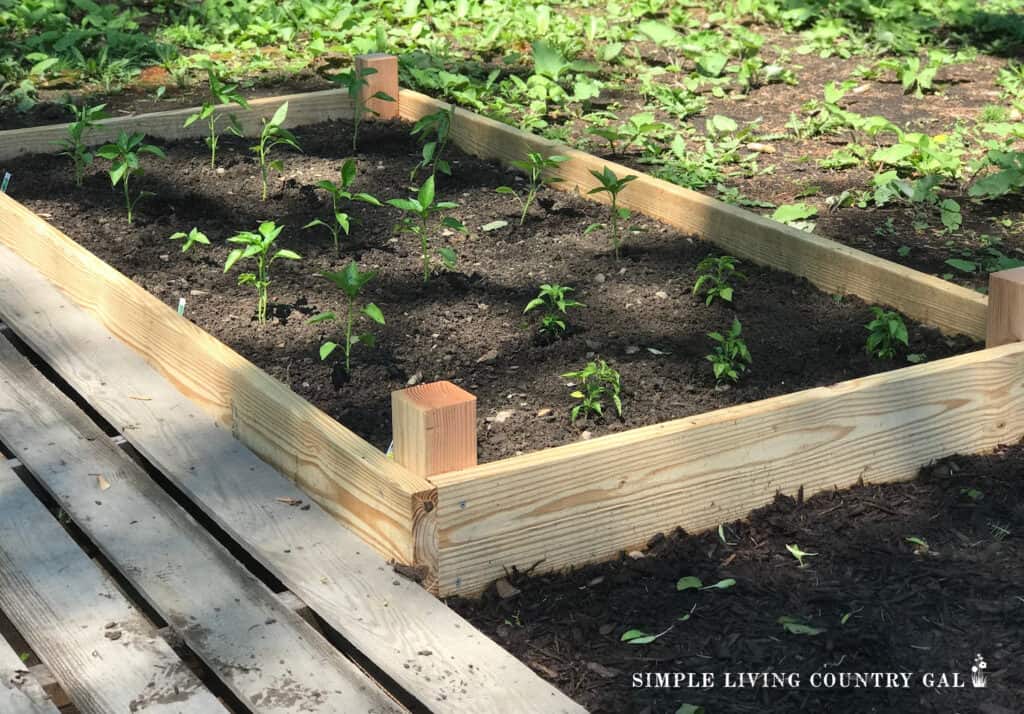
How to Harvest Bell Peppers
Once the plants start producing fruits, pick them as soon as they reach their full size and color. Regular harvesting will encourage the plants to produce more flowers and fruits. However, leaving the pepper on the plant a little longer helps them to become sweeter and increases their Vitamin C content. Use your best judgment and pick when they appear to be fully grown. Use a sharp knife or scissors to cut the pepper off the plant.
How to Store Bell Peppers
Peppers will do fine in the refrigerator for up to 10 days after harvesting when kept in plastic bags. They can also be frozen for future use; chopping them beforehand will make it easier to add them to your favorite recipes.
Diseases and Pests to Watch Out For
Like other fruits and vegetables in your garden, bell peppers are susceptible to some pests and diseases. A few to watch out for include:
• Flower drop – this can be caused by high heat or low humidity. If the air is too dry, douse the soil with water and mist the plants.
• Spider mites and aphids – these are two of the most common pests. They especially thrive in hot, dry weather, so mist the plants at the first sign of attack to deter them.
• Bacterial leaf spot – this causes black leaf spots and holes. Destroy any infected parts of the plant, do not compost them, and regularly remove any plant debris. Avoid overhead watering of the plants.
• Blossom-end rot – caused by a lack of calcium uptake causing dark, water-soaked spots on the blossom end of the fruit. Remove any affected fruit and maintain a pH of 6.5 in the soil.
• Colorado potato beetles – larvae and adults chew holes in the foliage and lay yellow-orange eggs in clusters on the underside of the leaves. Remove any eggs, larvae, or adults by hand, weed around the plants, and use straw mulch.
• Flea beetles – leave tiny holes in the leaves. Use row covers to block them, mulch heavily, and add native plants to attract beneficial insect predators.
• Leaf miners – leave blisters on the leaves caused by tunneling larvae. Remove any infected leaves, weed around the plants, use row covers, and till the soil early in the season.
Bell peppers can be a great addition to any garden, offering many ways to use them in your kitchen. By adding a few colorful varieties to your backyard garden, you will bring a delicious addition to your summer menu.
Other How to Grow Resources:
- How to Grow Sweet Potatoes for Beginners
- How to Grow Asparagus for Beginners
- How to Grow Chili Peppers for Beginners
How To Grow Bell Peppers
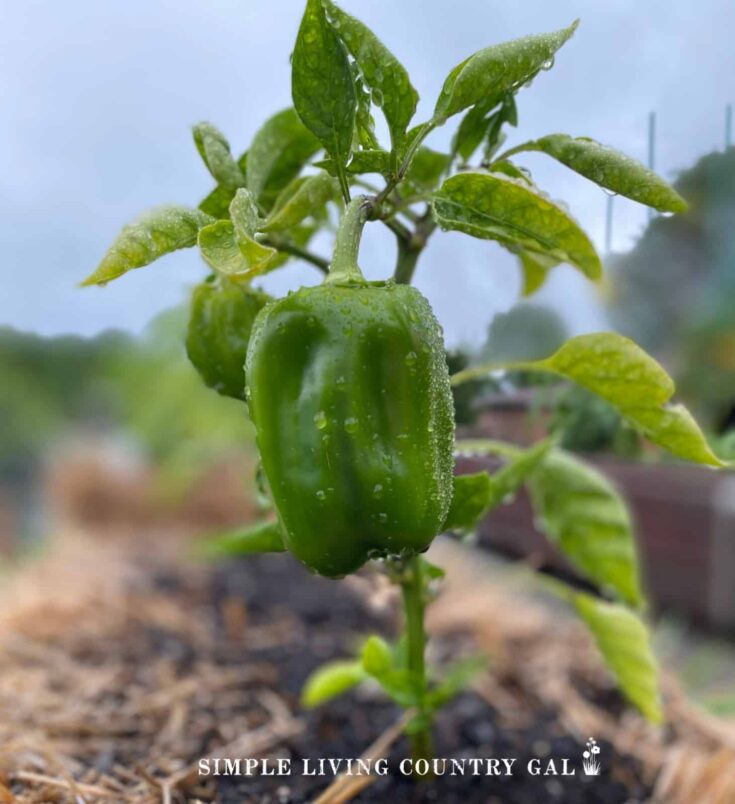
If you love fresh, delicious vegetables in the summer, this post is for you. How to grow big healthy bell peppers in your own backyard that are perfect for your summer salsa! Learn the steps you need for how to grow bell peppers for beginners step-by-step, from planting to harvest.
Materials
- Bell Pepper Seeds
- Water
- Wooden Matchsticks
- Low-nitrogen, High-phosphorus Fertilizer.
- Compost or Manure
Tools
- Garden or Garden Containers
- Stakes or Tomato Cages
- Rake
- Shovel
Instructions
- Start sowing the seeds indoors about 6-8 weeks before transplanting. Plant seeds 1/4" deep with 3 seeds to a pot.
- Once they start to grow, thin out the weakest seedling from each pot and let the other two grow together into one plant. This will create more leaves which will protect the peppers as they grow.
- Before transplanting outdoors, harden the seedlings off for about 10 day by placing them outside during the day so they can adjust to cooler temperatures gradually.
- Mix some aged manure and/or compost into the soil about 8 to 10 inches deep. Rake the soil to break up any large clumps. Don’t transplant into the ground until the soil temperature has reached at least 65°.
- Dig transplant holes about 3 to 4 inches deep and about 12 to 18 inches apart in a row. Rows should be spaced 2 to 3 feet apart.
- Before planting, fill the holes with water and let it soak in, then place 2 or 3 wooden matchsticks (for sulfur) and one teaspoon of a low-nitrogen, high-phosphorus fertilizer.
- Place the transplant in the ground about 1 inch deeper than they were in their original pot. Fill the hole with soil and pack it loosely around the plant, leaving a slightly sunken area around the plant base to hold water.
- After planting, give a good watering to encourage the roots to take hold in the new soil.
- Stake the plants now to avoid damaging the roots later. You can also you cages. This will help to prevent the plant from bending under the weight of the fruit as it grows.
- Once the plants start producing fruits, pick them as soon as they reach their full size and color.
- Peppers will do fine in the refrigerator for up to 10 days after harvesting when kept in plastic bags. They can also be frozen for future use; chopping them beforehand will make it easier to add them to your favorite recipes.
Notes
- Regular harvesting will encourage the plants to produce more flowers and fruits. However, leaving the pepper on the plant a little longer helps them to become sweeter and increases their Vitamin C content.
- When selecting a planting area, avoid areas where other members of the nightshade family have been planted (tomatoes, eggplants, potatoes). Planting in these areas makes the peppers more susceptible to disease.
- Transplant in the evening or on a cloudy day to keep the plants from drying too much and wilting.
Recommended Products
As an Amazon Associate and member of other affiliate programs, I earn from qualifying purchases.
-
Jobe's Organics 09627 Organic Fertilizer, 4 lb
-
SupKing Garden Plant Stakes,Sturdy Green Wood Bamboo Sticks 17" for Beans,Tomatoes,Vegetable and Potted Plants,Wooden Sign Posting Garden Sticks(30Pcs)
-
Seed Needs, Rainbow Bell Pepper Seeds for Planting (Capsicum annuum) Heirloom, Non-GMO & Untreated (1 Pack)



